Featured Comment:
“Already my family’s favorite. I used some Kurobuta pork belly as a topping and it is just perfect.”
– Edith
What is Okonomiyaki?
Okonomiyaki (お好み焼き) is a lot more complex than just “Japanese savory pancake.” This classic Japanese dish is all about getting the batter right and using the right ingredients.
“Okonomi” means “as you like,” but to get the authentic results, you’ve got to understand the fundamentals first. The techniques used in Osaka and Hiroshima styles are very different. This recipe focuses on the Osaka style, where all the ingredients are mixed together to make one smooth batter.
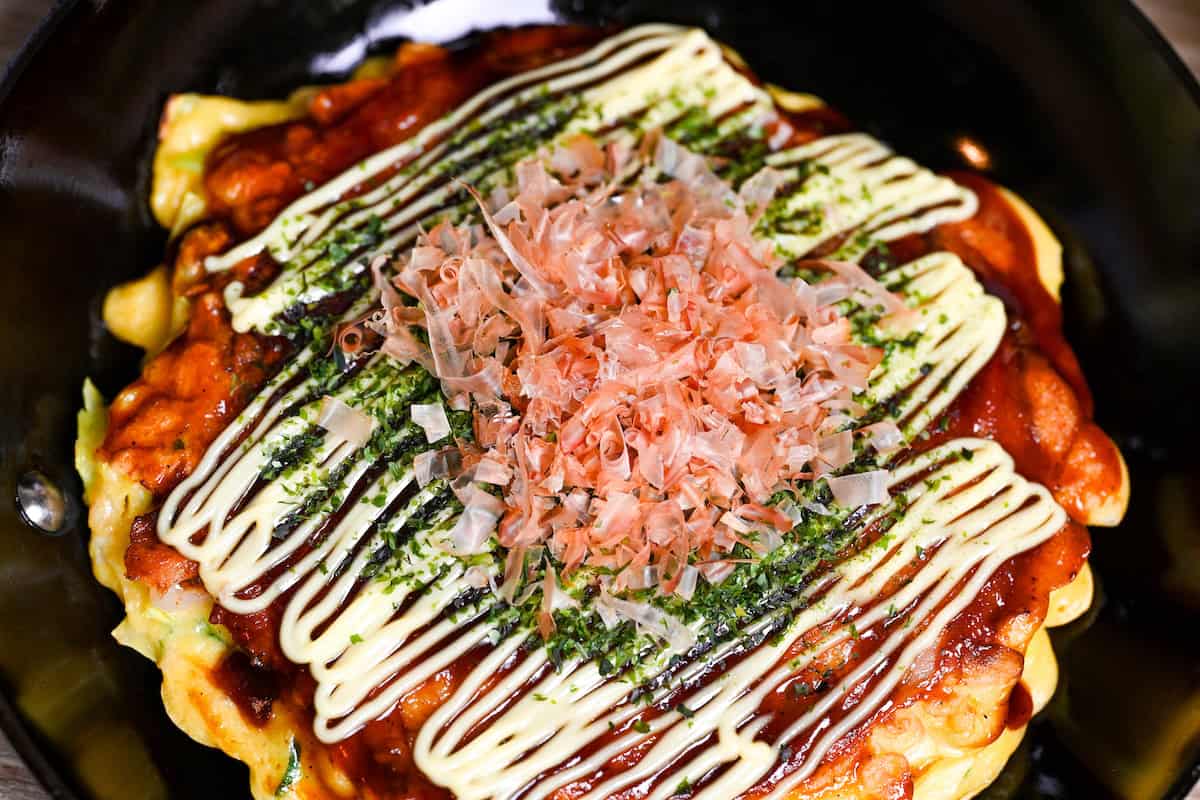
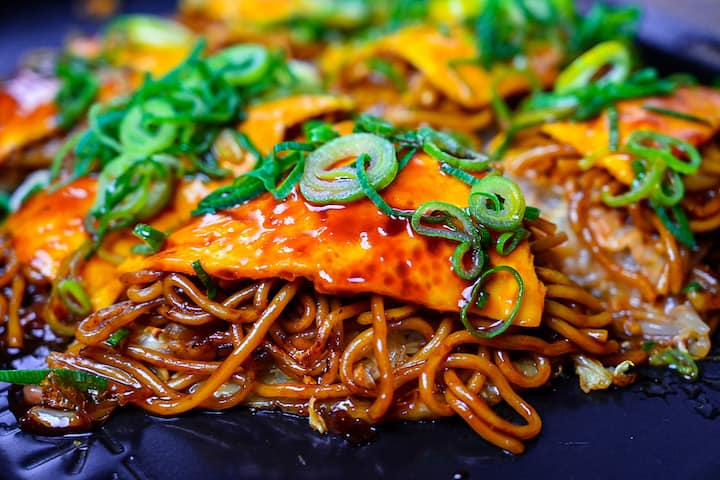
Most home cooks in Japan reach for pre-made okonomiyaki flour, but I’ve found that building the batter from scratch gives you full control over everything. I’ll walk you through the science behind the fluffiness and share practical substitutes for hard-to-source ingredients.
Once you get the hang of the technique, you’ll see why okonomiyaki is so popular.
Choosing Pork and Alternative Proteins
The protein component is key to making authentic okonomiyaki. While thinly sliced pork belly is the gold standard, understanding your alternatives lets you can create delicious results regardless of what’s available in your local area.
Protein Guide
| Protein | Method | Notes |
|---|---|---|
| Thinly sliced pork belly | Place on top before flipping | The most authentic choice; other thin-cut pork can substitute |
| Mixed seafood (squid, shrimp) | Mix into batter after brief sautéing | Sauté first to remove excess moisture and enhance aroma |
| Beef sinew | Pre-cook with seasonings, then mix into batter | Must be braised beforehand |
| Bacon | Place on top like pork belly | Reduce the okonomiyaki sauce to balance the extra salt, and make sure to use fatty bacon |
| Ground pork | Mix directly into batter | Not common in Japan but definitely an easy alternative |
| Imitation crab sticks | Shred and mix into batter | Perfect for seafood okonomiyaki on a budget |
| Ham | Slice thin and place on top | I much prefer bacon as a pork belly alternative |
| Scallops/Oysters/Clams | Mix into batter | Handle gently to avoid overcooking |
Key Understandings for Substitutions
- For meat alternatives: If pork belly isn’t available, look for proteins with a similar fat content. Bacon works well because of its fat-rendering properties, but you’ll need to adjust the salt content significantly.
- For seafood options: Sauté briefly before adding it to remove excess moisture and concentrate flavors. Canned options like scallops or tuna work well, but make sure to drain them thoroughly if they’re oil-packed.
- Understanding the role: Each protein has its own thing going on, like pork belly brings richness from the rendered fat, and seafood adds a complex oceanic umami flavor. So when you’re substituting, think about what flavor element you’re replacing and how to make up for it.
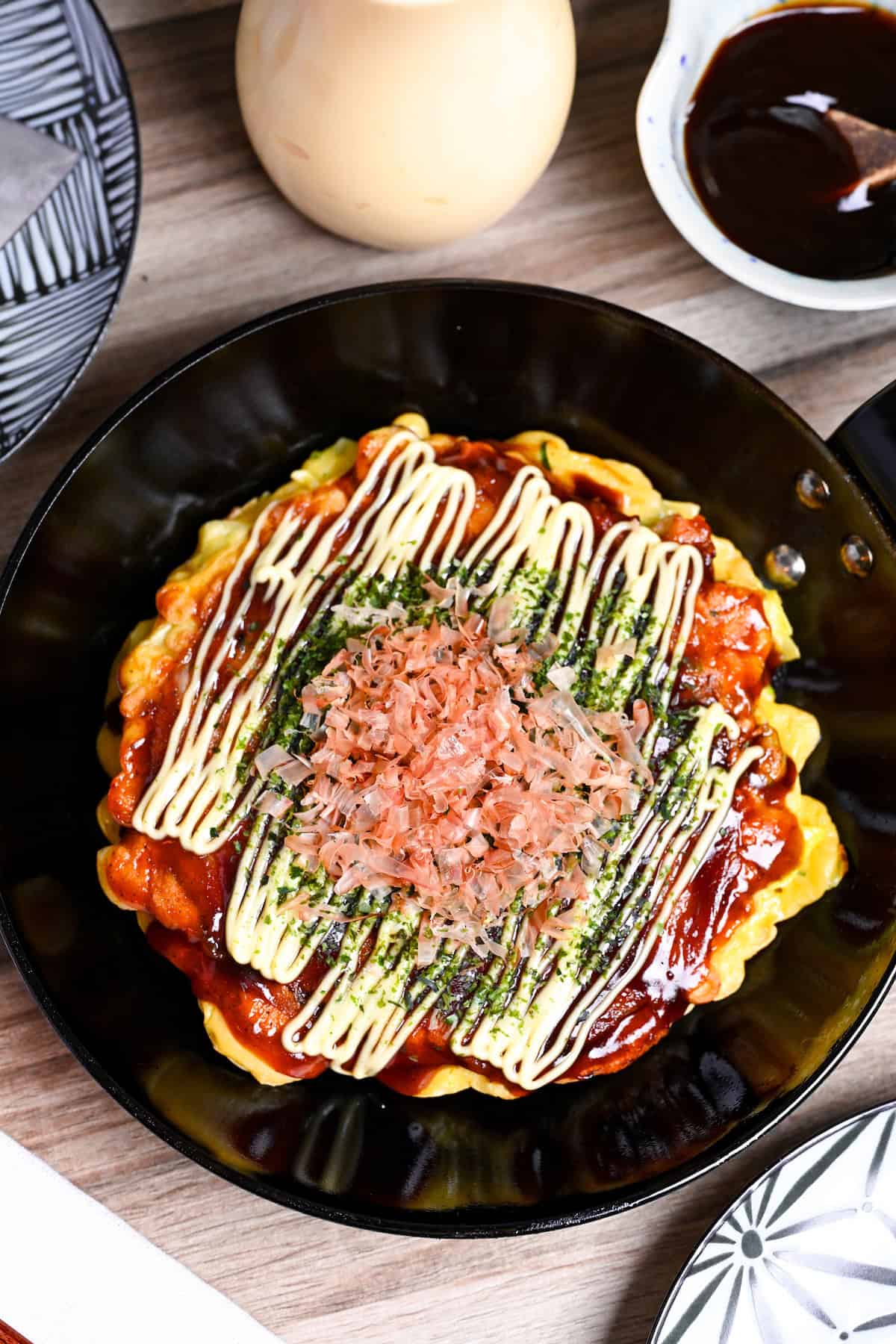
Secret Ingredients to Achieve Fluffy Texture
The key to making the ultimate okonomiyaki at home is understanding the science behind achieving that perfect fluffy texture. You can focus on mixing techniques, or you can promote it further with specific ingredients that create air pockets and keep the batter’s structure intact during cooking.
| Ingredient | Function | Texture Impact |
|---|---|---|
| Japanese Yam (Nagaimo/Yamaimo) | Creates natural binding gel that traps air bubbles | Produces silky, melt-in-your-mouth lightness with distinctive bounce, go-to in Japan |
| Baking Powder | Chemical leavening agent releases CO2 when heated | Creates consistent lift and airy structure, the most accessible alternative to yam |
| Grated Zucchini | Provides moisture and mild binding properties | Adds subtle moisture with gentle lift |
I picked baking powder as the leavening agent in this recipe because, let’s be real, nagaimo can be tricky to find outside of Japan.
But if you live in Japan, or you have access to Japanese yam, yam paste, or specialized yam powder, I highly recommend using those instead to get that authentic texture!
How to Customize Your Okonomiyaki
“Okonomi” means “as you like it.” This flexibility makes it great for adapting to local ingredients and personal preferences. Other than the batter and the sauce, you can pretty much customize it however you like.
Customization Guide by Flavor Profile
| Ingredient | When to Add | Tips |
|---|---|---|
| Green Onions | Mix into batter | Use just the green parts for color and mild flavor |
| Garlic Chives | Mix into batter | Cut 3-5cm lengths for even distribution |
| Kimchi | Mix into batter (drained) | Drain well; reduce other salt seasonings |
| Sweet Corn | Mix into batter | Frozen corn works; drain canned corn |
| Sakura Ebi | Mix into batter | N/A |
| Cheese | Mix into batter OR sprinkle on top before flipping | Try mixing into batter for even distribution |
| Mochi (Rice Cake) | Dice small, mix into batter | Don’t overdo it |
| Mentaiko | Mix small amounts into batter | Pairs excellently with cheese and mochi |
| Potato Chips | Replace tenkasu entirely | Use plain salted varieties only |
Timing Strategies
- Mix into Batter: Creates even flavor distribution throughout the entire pancake. Best for ingredients where you want subtle, integrated taste.
- Top Before Flipping: Allows ingredients to melt or cook into the surface while maintaining distinct pockets of flavor. Perfect for cheese.
- Post-Cooking Garnish: It’s got a intense flavor and looks great. Great for ingredients that lose their texture or flavor when cooked.
However, before diving into customizations, I suggest you get the hang of the basic version first. If you understand how the standard recipe works, you’ll have the foundation you need to experiment successfully. And when you’re trying something new, start slow. You can always add more next time, but it’s hard to dial back overpowering flavors once they’re mixed in.

Visual Walkthrough & Tips
Here are my step-by-step instructions for how to make Osaka-style Okonomiyaki at home. For ingredient quantities and simplified instructions, scroll down for the Printable Recipe Card below.
If you prefer to watch the process in action, check out my YouTube video of this Okonomiyaki recipe for a complete visual walkthrough!
In a large mixing bowl, combine sifted cake flour and baking powder.
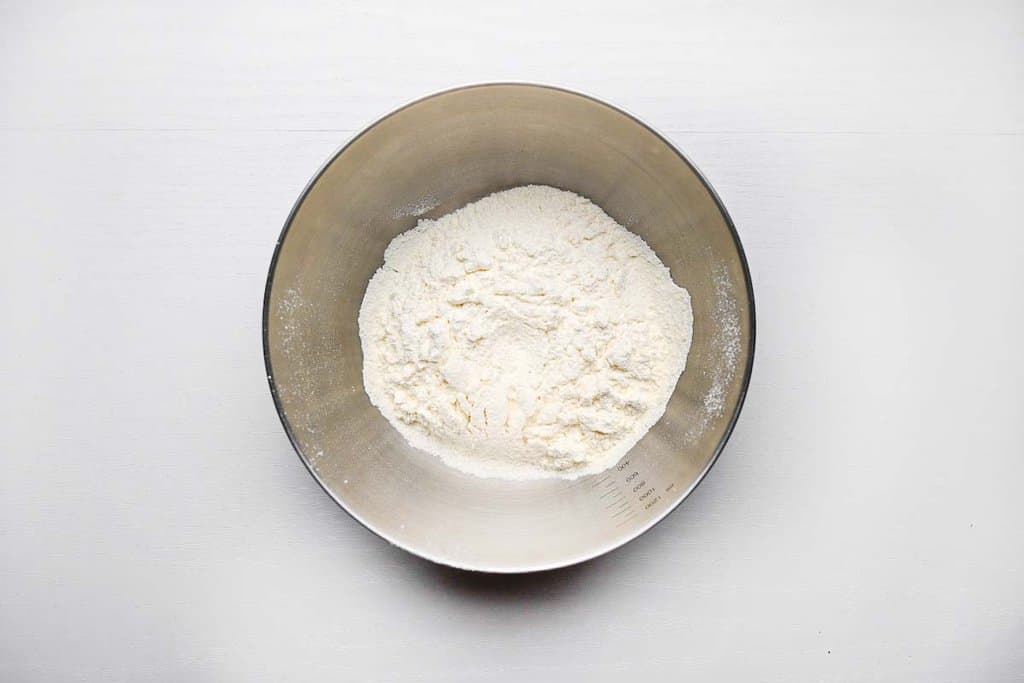
Then, whisk in the cooled dashi, milk, soy sauce, mirin, and egg until just combined.
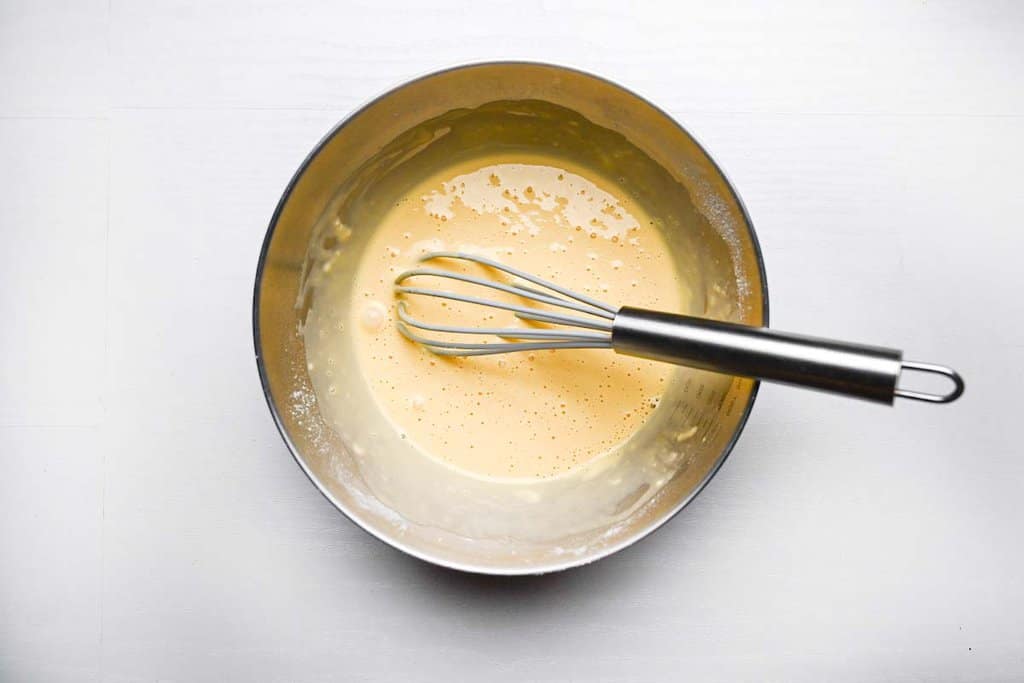
Whether you use instant dashi, dashi packets, or homemade dashi, hot dashi can make gluten develop too quickly, which can make the mixture gummy and heavy. So, make sure to use dashi that’s either room-temperature or chilled.
Cover the bowl and chill it for at least 30 minutes (an hour is even better) while you get everything else ready.
Resting lets moisture distribute evenly and gives the gluten network time to settle, helping you get a thicker, easier-to-shape okonomiyaki. If you really don’t have time, you can skip the rest, but the pancake may spread a bit more.
Mix Worcestershire sauce, oyster sauce, ketchup, honey, and soy sauce in a small bowl and set it aside for later. If you already have store-bought okonomiyaki sauce, you can skip to the next step.
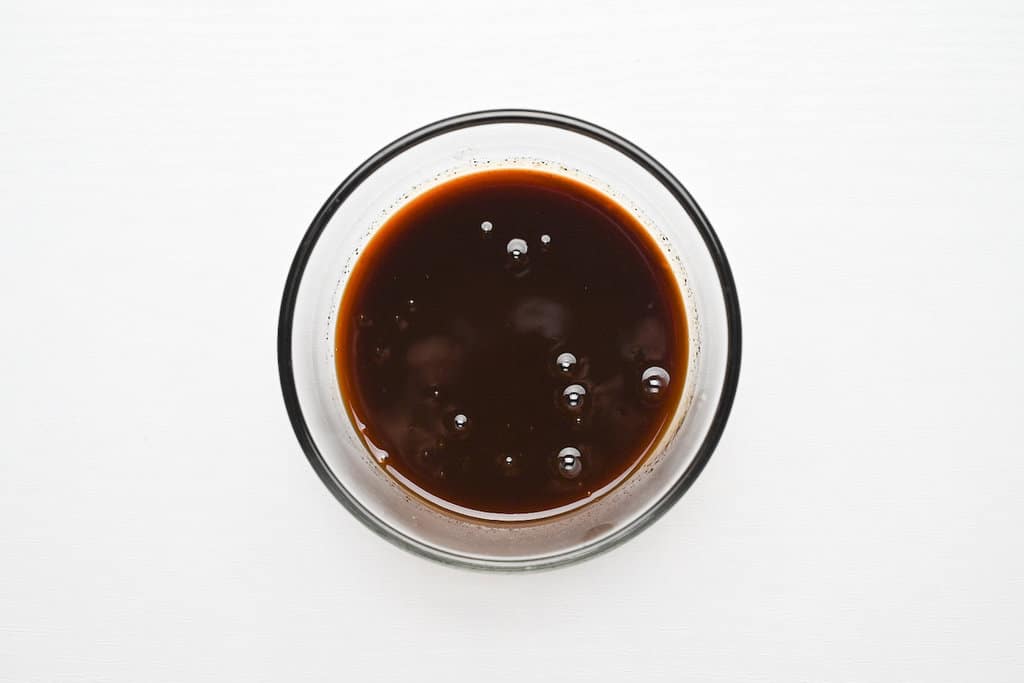
You can also adapt the ingredient ratio to suit your tastes. For example, add more honey or ketchup if you want it sweeter. If you want it to be saltier, add more soy sauce or even a pinch of salt.
It is undeniable that cabbage is one of the most important ingredients for okonomiyaki, and it should be cut roughly yet finely.
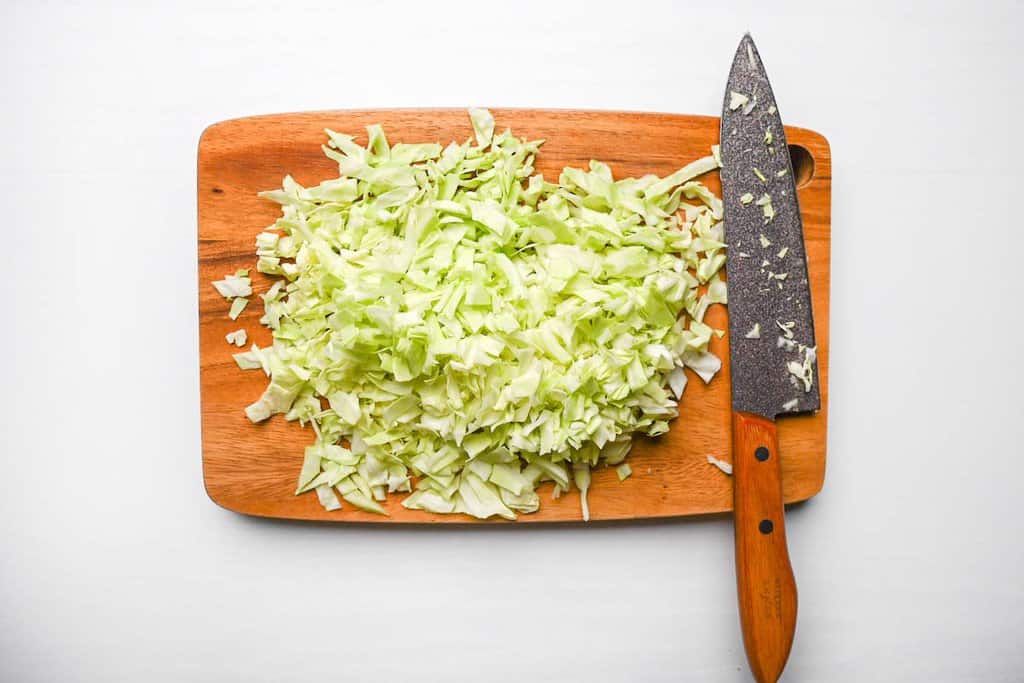
If you cut it too thin or finely, the moisture from the cabbage starts to leak out, negatively affecting the texture of your okonomiyaki. By cutting it small but rough, you can enjoy the texture of the cabbage and avoid making your batter sticky or watery.
Try spring, green, or pointed types; go for tender over dense. Tough winter cabbages take longer to soften and can weigh the batter down.
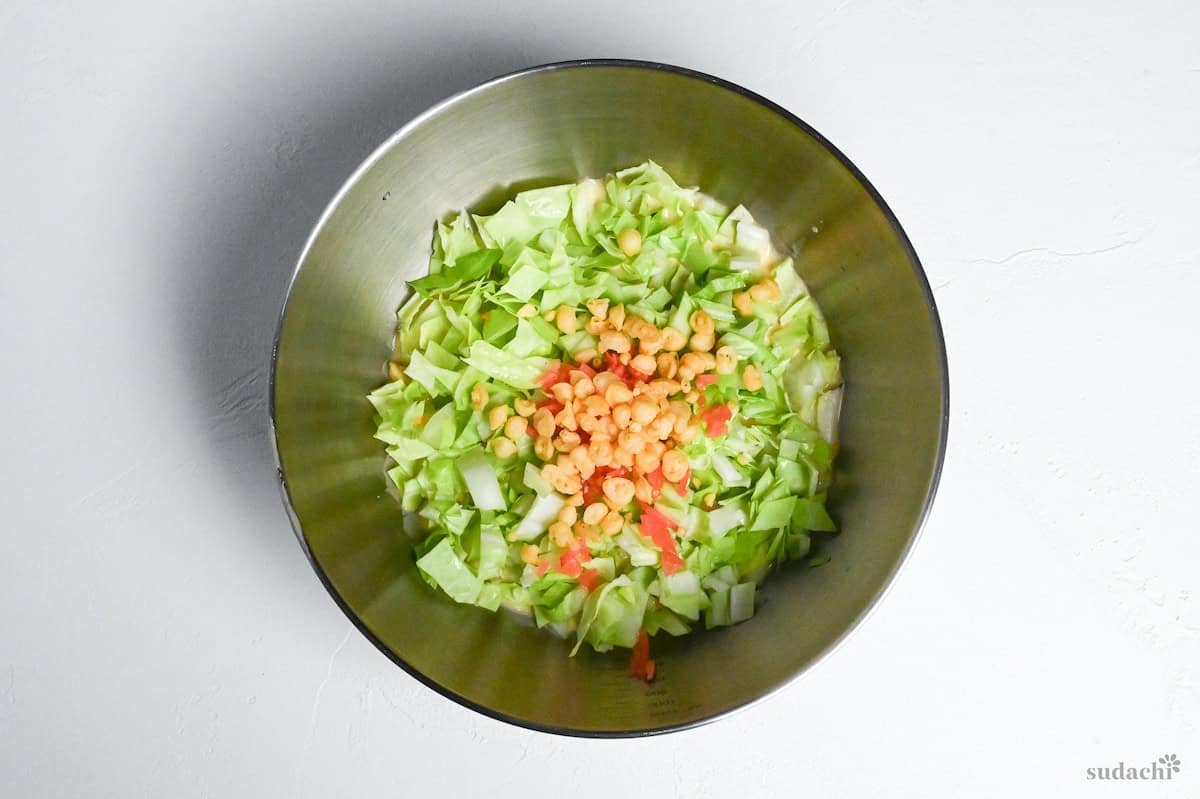
Divide the rested batter into two bowls (one goes back in the fridge while you cook the first pancake).
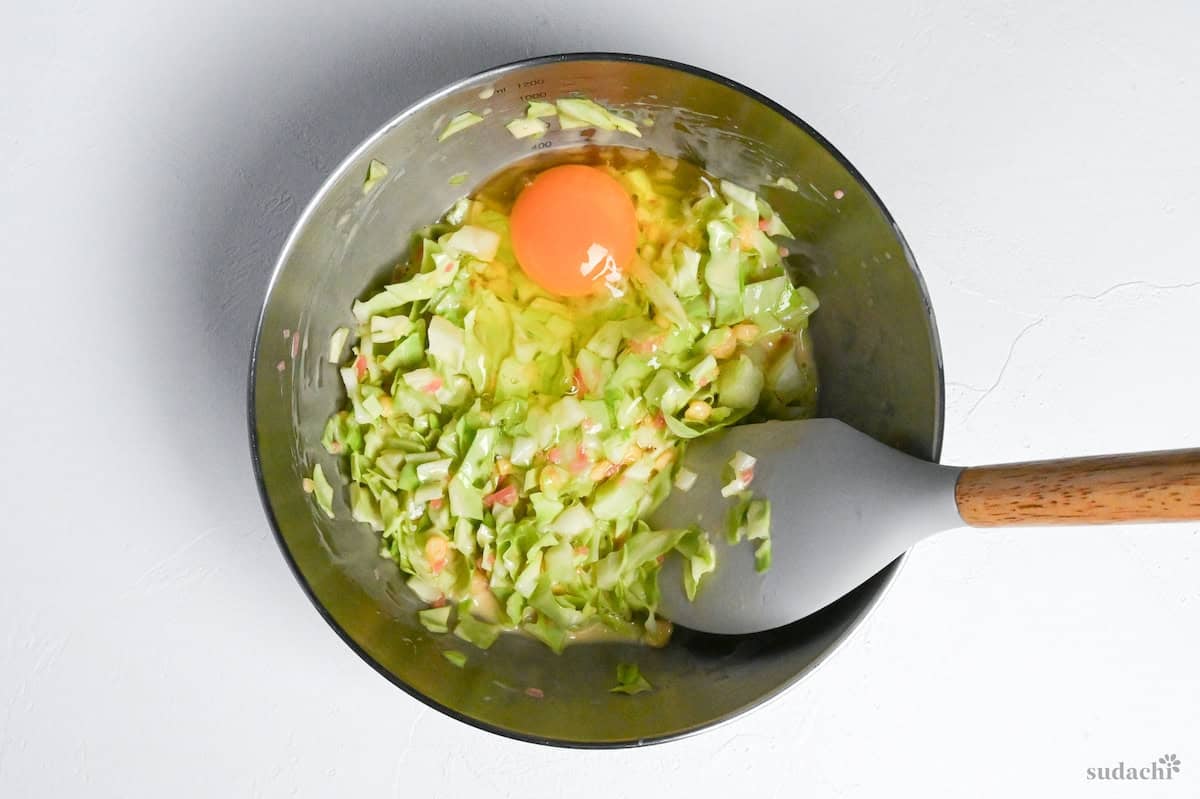
Working quickly so the cabbage stays crunchy, fold ½ of the chopped cabbage, tenkasu (sub crushed plain potato chips in a pinch), and minced pickled ginger into the batter. Crack in an extra egg and stir just until you stop seeing streaks.
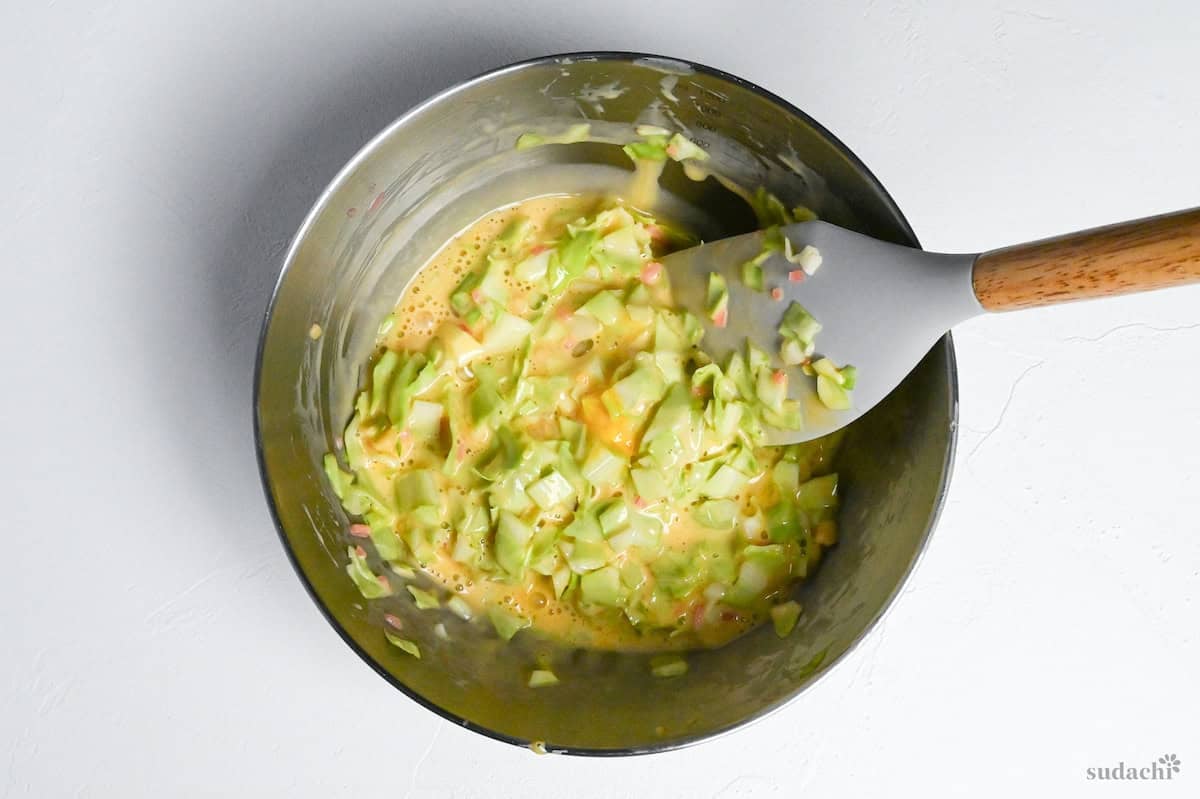
If you over-stir, you toughen the gluten and knock out the air. If you under-mix, you end up with unstable pockets that collapse when you flip the dough. Try for a light 30-second fold that feels more like tossing a salad than whipping cake batter.
If you’re chasing ultra-light texture and don’t mind the extra work, beat the egg whites to soft peaks and fold them in. I personally don’t usually do this but it’s fun to make sometimes if you like that soufflé-like texture.
Heat a well-seasoned cast-iron or heavy stainless skillet over medium-high heat until a bit of water dances and evaporates.
Cast iron retains heat, which sears the crust before the center overcooks. Non-stick works okay, but don’t crank it up too high because the coating doesn’t do well with extreme temperatures.
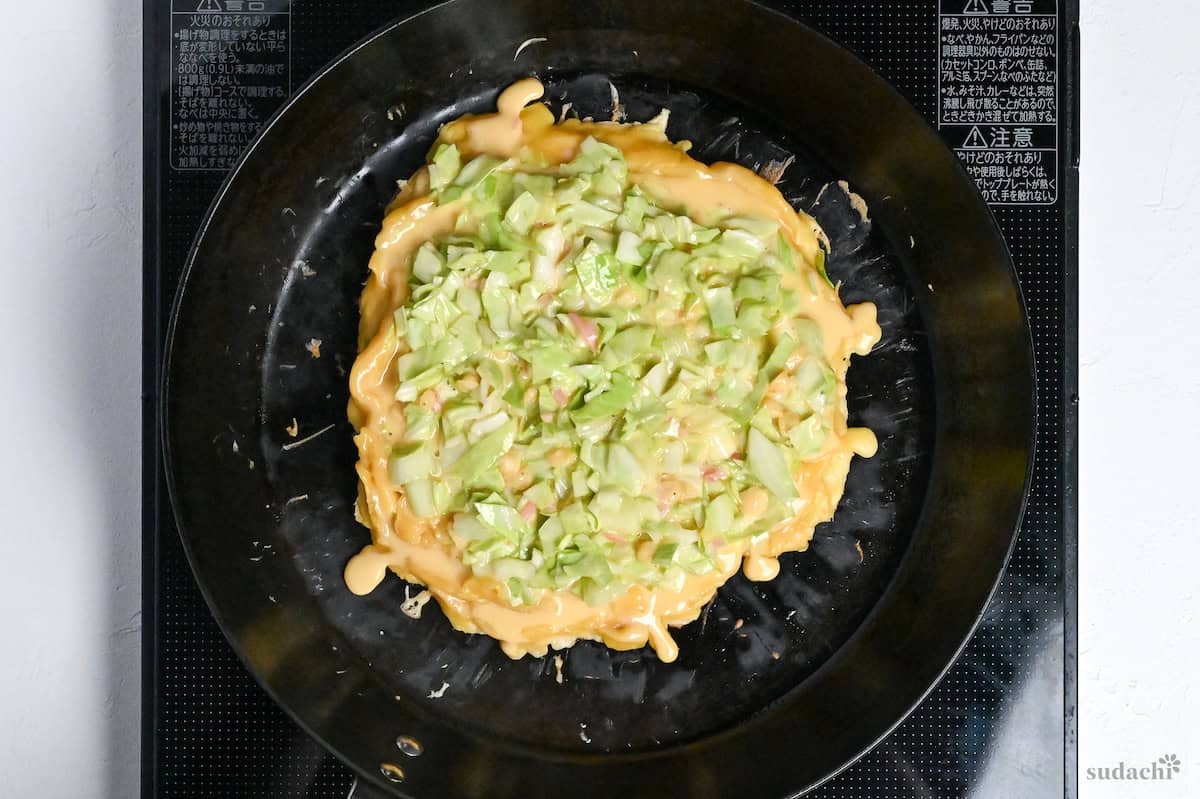
Add a thin layer of neutral oil, then pour the batter into the center. Use a spatula to shape it into a circle that’s 14-16cm (about 6½ inches) wide and 2cm (just under ¾ inch) thick. This is the “average” size.
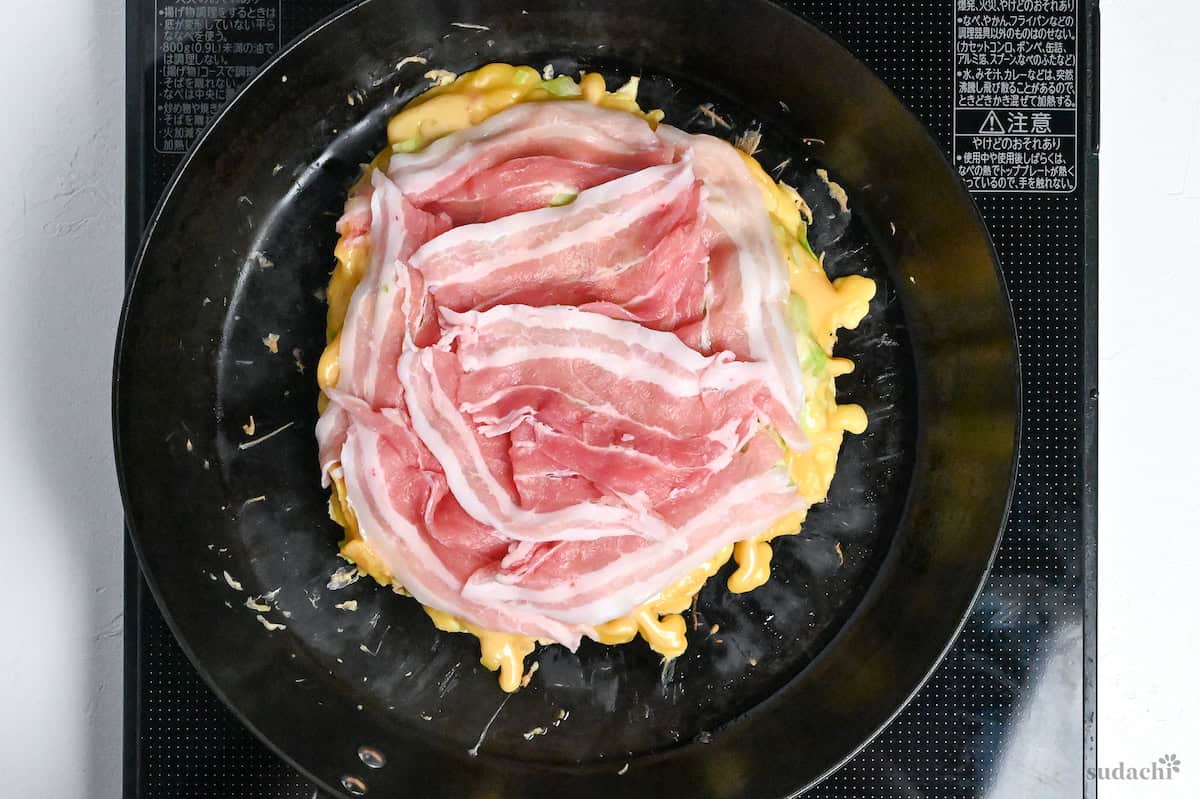
Lay thin pork belly slices over the surface. As the meat sizzles, its rendered fat effectively shallow-fries the top, adding smokiness and preventing curl.
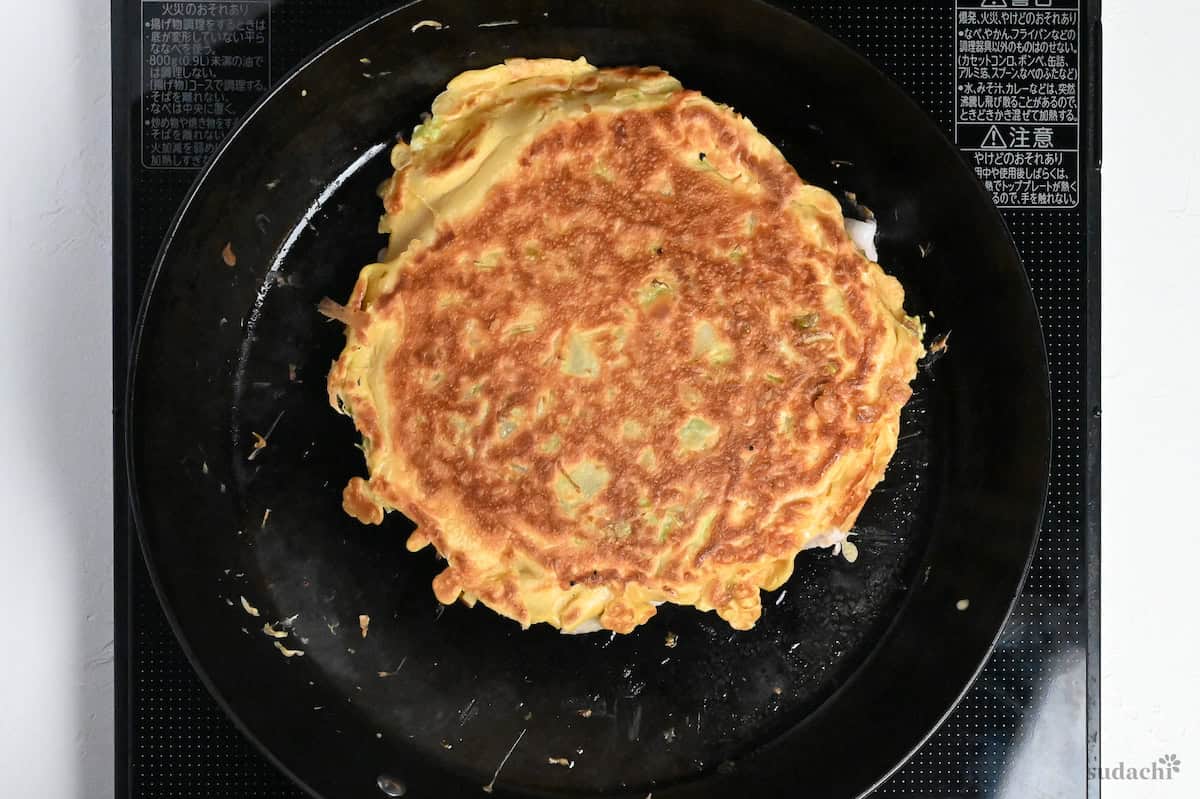
When the edges are dry and the bottom is a deep golden color, slide a wide spatula (or two smaller ones) under the cake and flip it in one confident motion. Then, turn the heat down to medium-low, put the lid on, and let the steam finish cooking for 5 minutes.
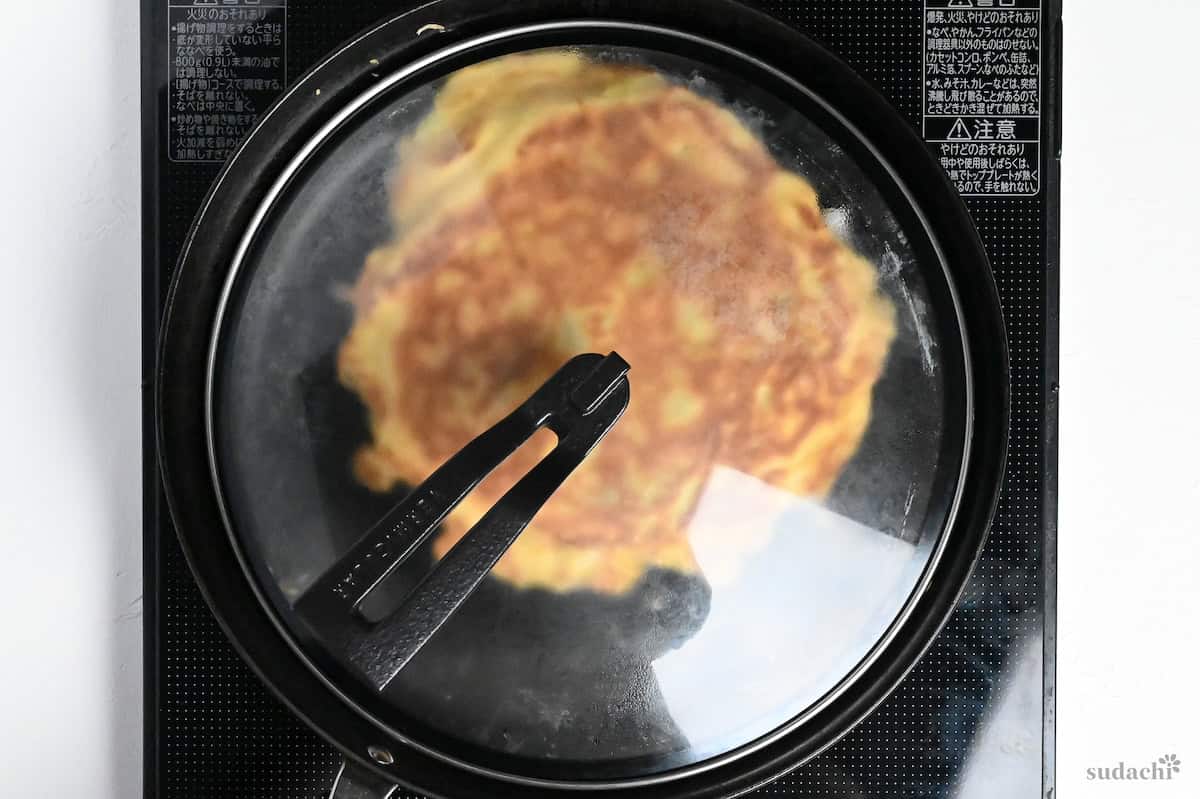
Resist flattening with your spatula. Pressing squeezes out the air and water vapor that make the interior light and juicy.
Steam brings gentle, all-around heat so the center sets without burning the crust. Take the lid off after 5 minutes re-crisp the surface and get rid of any excess moisture.
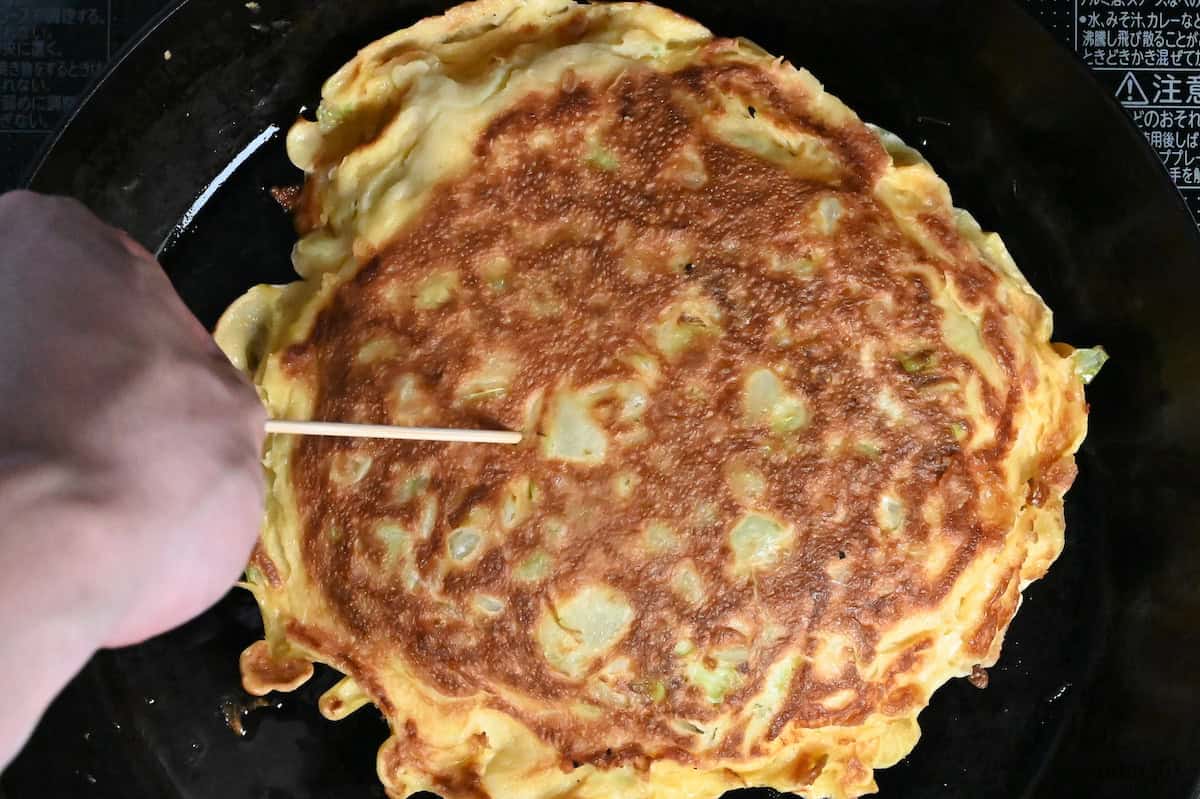
Poke the center of the pork with a toothpick. If it comes out batter-free, flip it again so the pork faces up. Just brush half of the sauce on, drizzle in thin lines of mayo, and then shower with bonito flakes and a pinch of aonori right before serving.
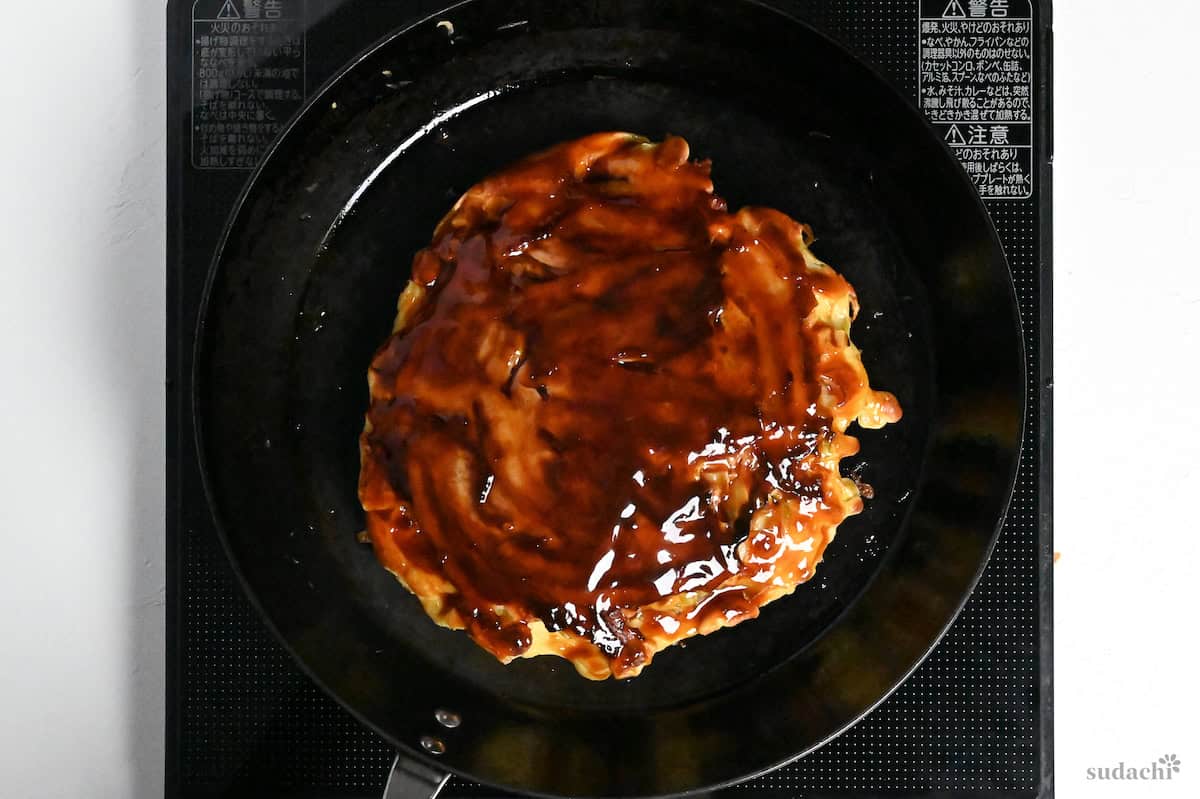
The heat will make the bonito dance, and the aonori’s sea aroma will really pop when you add it last.
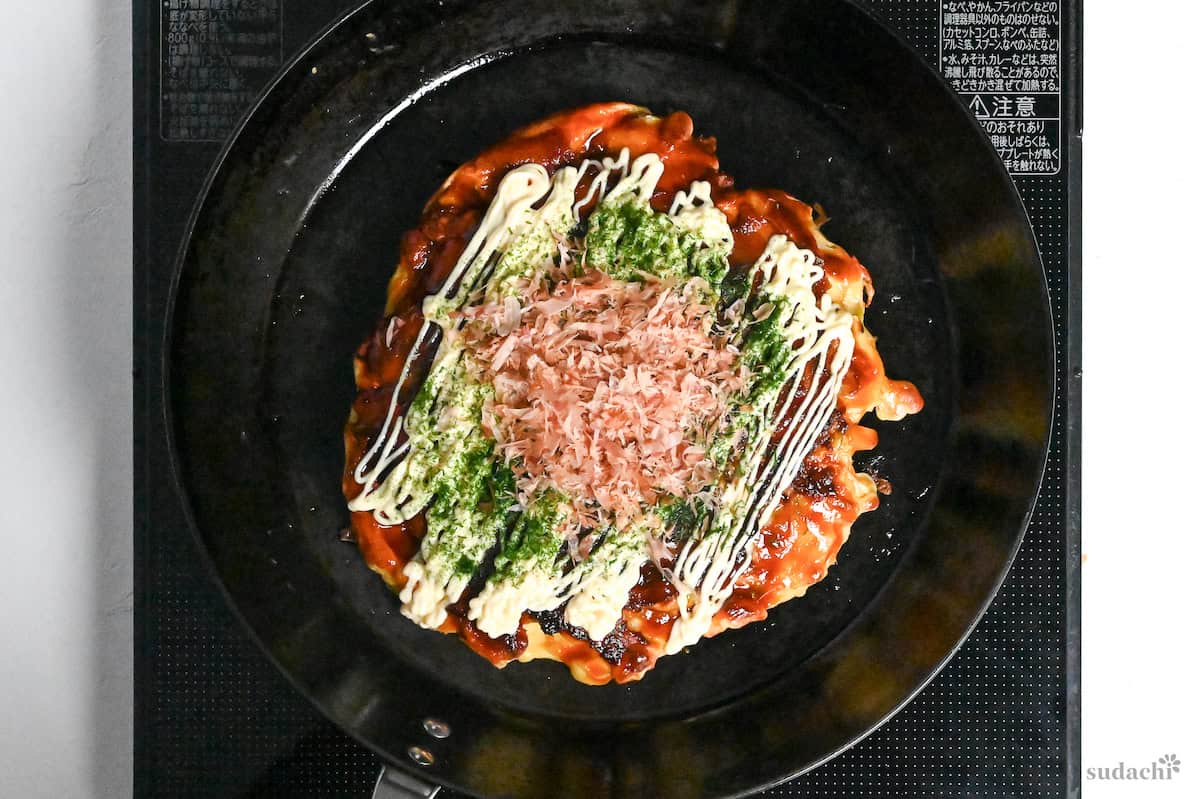
Slice it into wedges (a pizza cutter works great) and enjoy while it’s still hot. Just repeat the whole process with the second bowl of batter. And feel free to nibble on the first one while you wait!
Jump to Full Recipe Measurements
Essential Tips & Tricks
- Always add room-temperature (not hot) or cold dashi to the flour so the batter stays light instead of gummy.
- Let the batter rest in the fridge for 30–60 minutes; it hydrates the flour and keeps the pancake from spreading thin.
- Flip only when the edges look dry and the bottom is deep golden. Rushing the flip is the #1 cause of breakage.
- Cover the pan for 5 minutes to steam-cook the center.
- Add sauce, mayo, bonito flakes, and aonori right before serving.
With these simple tips in mind, you’re set for success every time you make Okonomiyaki.
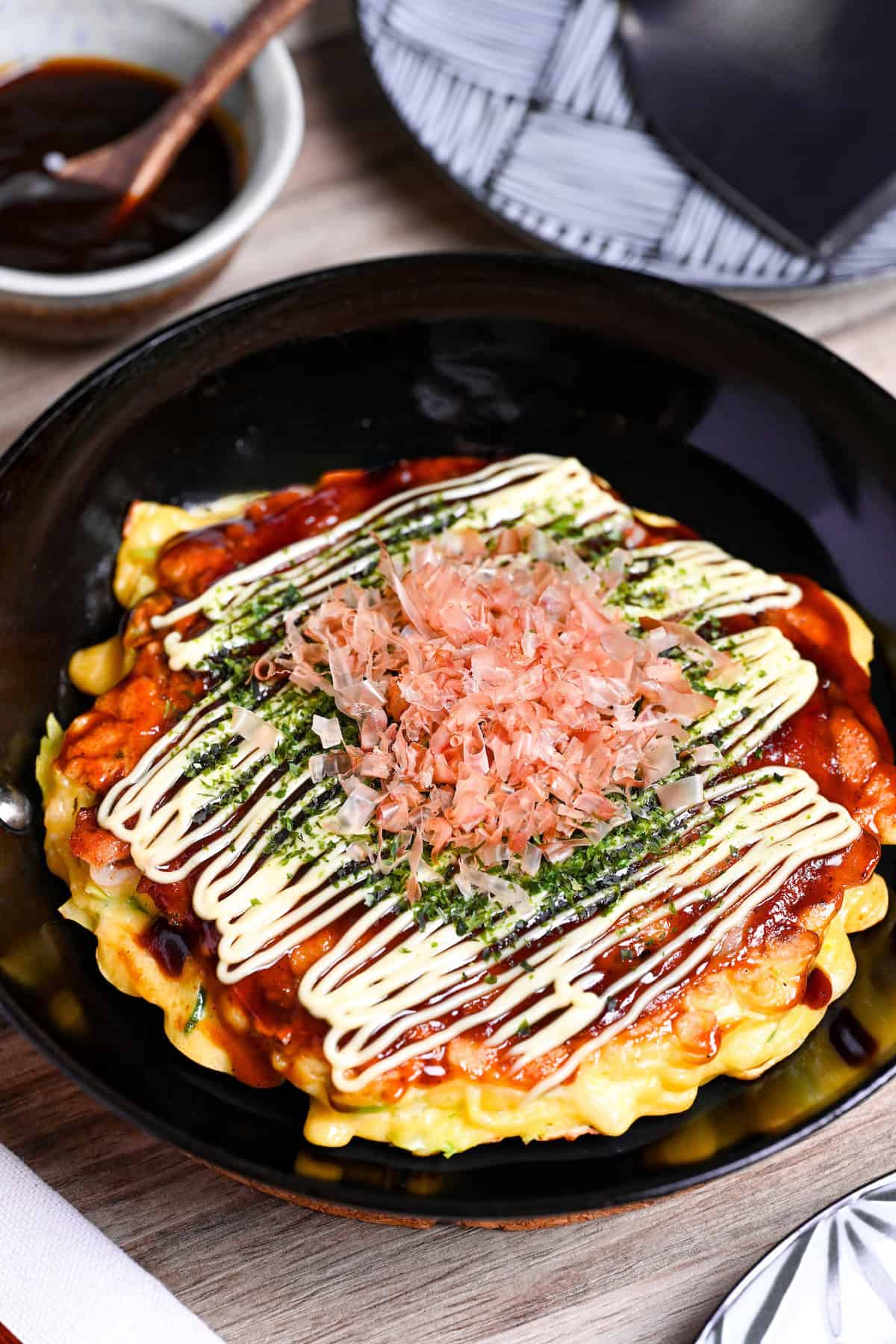
Meal Prep & Storage
This okonomiyaki recipe can actually be meal-prep friendly. It’s great when you want something quick and easy to heat up.
- Full Dish Prep: Cook the pancakes completely, let them cool, then cut each into quarters. Wrap the pieces individually in plastic wrap and seal in a freezer bag, pressing out excess air. Freeze for up to 1 month. Reheat from frozen in the microwave (about 2 ½ – 3 minutes for two pieces at 600 W) and finish in a dry skillet or toaster oven for 1–2 minutes to crisp the surface, then apply the sauce and toppings.
- Component Prep: Whisk the sauce in advance. It keeps 5 days refrigerated in a jar.
- Storage Guide: Cool cooked pancakes to room temperature, wrap tightly, and chill up to 2 days or freeze up to 1 month. Keep sauces in separate airtight containers in the fridge and add after reheating for the best flavor and aroma.
Serving Suggestions
Troubleshooting & FAQ
Here are answers to frequently asked questions I have received across all platforms, including here, YouTube, Instagram, and Pinterest. If you have any questions, feel free to send them to me anytime! It will be a big help for everyone in this community!
You probably cranked up the heat too high, so the surface browned before the middle cooked all the way through. Cook on medium heat, cover the pan for 5 minutes after flipping, and check the doneness with a toothpick. If it comes out clean and warm, you’re good to go. If not, reduce the heat, cover and continue to steam until its fully cooked to your liking.
Absolutely. Put the pancake back in the pan, cover it, and cook it over low heat until it’s ready. Or, if you’re in a hurry, just microwave it for a minute (600 W) with plastic wrap on top. It might not look perfect, but the texture will recover.
It’s mostly due to extra moisture. It’s usually from watery cabbage or adding liquids too early. Pat the cabbage dry, mix the fillings into the batter right before cooking, and keep the stove at medium rather than low (low heat steams the pancake).
There are two main reasons why this might happen: not enough binding and flipping too soon. Mix the batter and fillings for about 30 seconds to activate the gluten, use the recommended amount of egg, and don’t flip until the edges look dry and the bottom is a deep golden color.
If you’ve got small eggs or not enough of them, it’ll reduce the binding power. If your eggs are small, go ahead and add an extra one. The protein in the eggs will act like glue and help the pancake hold together.
After shaping, start on medium-high just until the bottom sets, then drop to medium-low and cover.
Over-mixing or using hot liquid can overdevelop gluten. Add room-temperature dashi and stir only until the flour is moistened. Lumps are fine.
It could be that the batter is too thin or the pan isn’t hot enough. You can reduce the dashi slightly or add a spoonful of flour, and always preheat the skillet until a water droplet sizzles.
It traces back to early-1900s Tokyo street foods like monjayaki and dondon-yaki. Kansai vendors thickened the batter, added more toppings, and, after WWII rationing, mixed cabbage and cheap proteins, calling it “okonomiyaki” (“cook what you like”). By the 1950s, this hearty pork-topped version had become Osaka’s signature soul food.
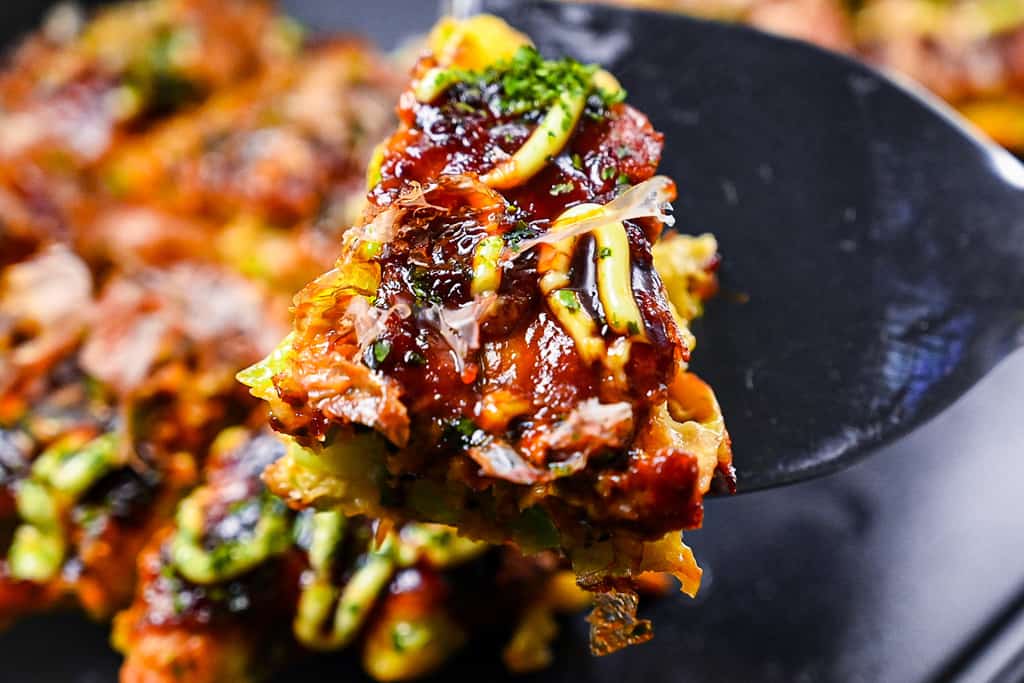
I hope you enjoy this Authentic Osaka-style Okonomiyaki recipe! If you try it out, I’d really appreciate it if you could spare a moment to let me know what you thought by giving a review and star rating in the comments below. It’s also helpful to share any adjustments you made to the recipe with our other readers. Thank you!
More Japanese Street Food
Hungry for more? Explore my street food recipe collection to find your next favorite dishes!
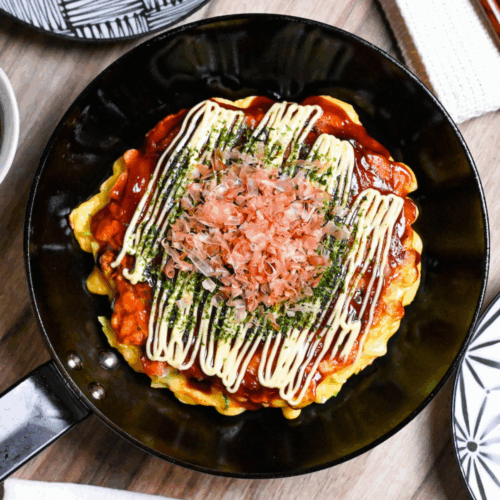
Authentic Osaka Style Okonomiyaki (Traditional Japanese Savory Pancake)
Ingredients
Batter
- 100 g cake flour or all-purpose in a pinch
- ⅛ tsp baking powder
- 75 ml dashi stock cooled
- 1 tsp milk
- 1 tsp Japanese soy sauce (koikuchi shoyu)
- 1 tsp mirin
- 1 egg relatively large
Okonomiyaki Sauce
- 2 tbsp tomato ketchup
- 1 tbsp Worcestershire sauce
- 1 tbsp oyster sauce
- 1 tbsp honey
- 1 tsp Japanese soy sauce (koikuchi shoyu)
Fillings (see in post for more ideas)
- 150 g green cabbage or spring/pointed cabbage
- 2 tbsp tempura flakes (tenkasu) optional, or crushed plain potato chips
- 2 tsp red pickled ginger (benishoga) optional
- 100 g thinly sliced pork belly
- 2 tbsp cooking oil neutural flavor
- 2 eggs
Toppings (see in post for more ideas)
- Japanese mayonnaise to taste
- bonito flakes (katsuobushi) to taste
- aonori (dried green seaweed powder) to taste
My recommended brands of ingredients and seasonings can be found in my Japanese pantry guide.
Can’t find certain Japanese ingredients? See my substitution guide here.
Instructions
Batter
- Sift 100 g cake flour and ⅛ tsp baking powder into a large bowl. and add the 75 ml dashi stock, 1 tsp milk, 1 tsp Japanese soy sauce (koikuchi shoyu), 1 tsp mirin and 1 egg to the bowl. Mix until the ingredients are well incorporated, but be careful not to over mix.

- Cover the bowl and rest it in the fridge for 30 minutes.

Okonomiyaki Sauce
- Take a small bowl and add 2 tbsp tomato ketchup, 1 tbsp Worcestershire sauce, 1 tbsp oyster sauce, 1 tbsp honey and 1 tsp Japanese soy sauce (koikuchi shoyu). Mix well and set aside for later.

Fillings
- Cut the 150 g green cabbage into into small rough pieces.Once the batter has been resting for 30 minutes, pour half of it into a new bowl. Place the original bowl back in the fridge for later. Alternatively, make two simultaneously in two separate frying pans.

- Start preheating your pan on a medium/medium-high setting.While you wait, add half of the cabbage to the bowl of batter along with 1 tbsp tempura flakes, and 1 tsp red pickled ginger. If you want to add other ingredients such as cheese, kimchi, mochi etc add them here. See in post for more ideas. Mix until everything is evenly distributed.

- Add 1 egg and mix again until it's incorporated. Be careful not to over mix.

- Add the oil to the pan and swirl around until evenly coated. Wipe out the excess with kitchen paper and pour the okonomiyaki mixture into the center of the pan. Use a spatula to neaten up the edges.

- Lay the slices of pork belly over the top of the wet mixture and fry the okonomiyaki until the bottom starts to become brown and crispy.

- Carefully flip it over and place a lid on the pan. Reduce the heat to medium-low and continue to fry with the lid for about 5 minutes or until cooked all the way through.

- Pierce the middle with a toothpick to make sure it's cooked. If the toothpick doesn't come out clean, continue to cook on a low heat and check it every few minutes until it's done.

- Once it's cooked through, flip it over again and pour half of the sauce over the top. Use a pastry brush or spoon to spread it evenly. You can do this while it's still in the pan or transfer it to a plate first.

- Drizzle with mayonnaise and sprinkle generously with bonito flakes and aonori then repeat steps 2-8 with the other bowl of batter in the fridge. Enjoy!

Video
Notes
- If you can get okonomiyaki flour, then you can replace the dashi stock with plain water. Check the package for more detailed instructions.
- This recipe makes two okonomiyaki pancakes, which should be enough for 2-4 people.
- Use cake flour for a light, soft texture, or substitute with all-purpose flour if you have to.
- Cool dashi completely before mixing with flour to prevent sticky, heavy batter.
- Freeze cooked, cooled quarters without sauce for up to 1 month. Microwave to heat through, then skillet-sear or toaster oven to bring back a bit of texture before adding toppings.






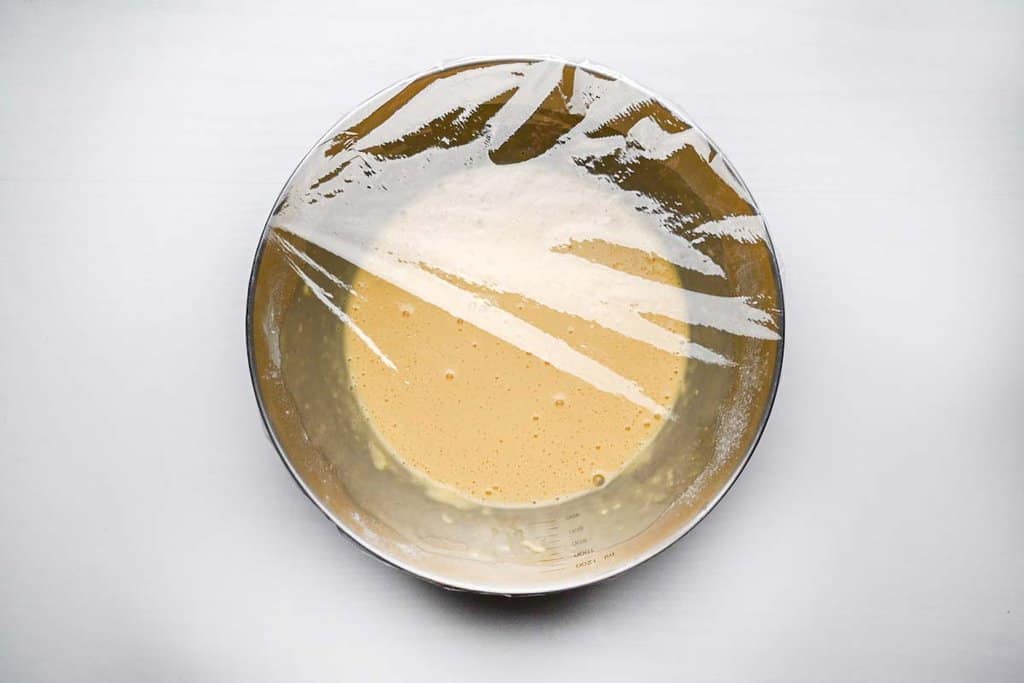
made it with shrimps topping, and it was superb. the instructions are easy to follow and the result is great.
Hi Hadas,
Thank you for sharing your experience and picture! Looks good! I’m glad you enjoyed the recipe!
Yuto
Already my family’s favorite. I out some Kurobuta pork belly as a topping and it is just perfect.
Hi Edith,
Thank you so much for trying this recipe and sharing your photo! Looking great! I’m happy to hear this has become a family favorite already! 🙂
Yuto
Haven’t made the recipe yet but have made it before. Great background info and explanation. Has plenty of options and substitutions. Glad that fixes are included.
Good job. I subscribed for these reasons.
Hi Margaret,
Thank you so much for your lovely words! I’m happy to hear you enjoyed the content!
Yuto